Frozen Shrimp Market Research, 2032
The global frozen shrimp market size was valued at $9.9 billion in 2022, and is projected to reach $21.9 billion by 2032, growing at a CAGR of 8.3% from 2023 to 2032.
The increasing demand for convenient food options is a significant frozen shrimp market growth factor. According to a report by the National Fisheries Institute, shrimp is the most consumed seafood in the United States, with an average annual consumption of over 4 pounds per capita. Frozen shrimp is a type of shrimp that has been harvested, processed, and then frozen to maintain its freshness and flavor. To preserve its quality, the shrimp is rapidly frozen at very low temperatures, usually below -18°C (-0.4°F), which stops bacterial growth. This preservation method allows consumers to store the shrimp for longer periods without compromising its taste or texture. Frozen shrimp is a popular seafood choice worldwide because it can be used in various cuisines, is readily available throughout the year, and retains its nutritional value. Moreover, frozen shrimp undergoes rigorous quality control measures to ensure it is safe to eat.
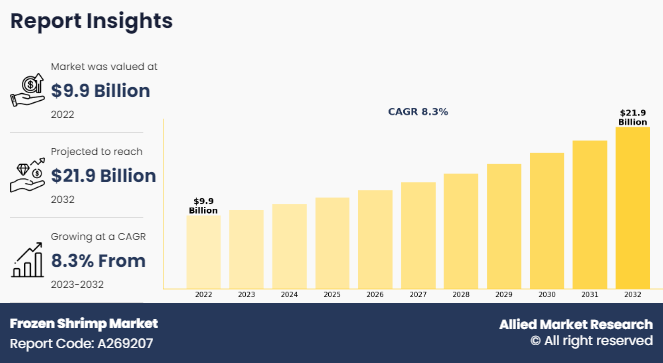
Key Takeaways
By application, the food segment was the highest revenue contributor to the frozen shrimp Industry in 2022 and is expected to grow at a significant CAGR during the forecast period.
By source, the organic segment was the highest revenue contributor to the market in 2022 and is expected to grow at a significant CAGR during the forecast period.
By distribution channel, the B2B segment was the highest revenue contributor to the market in 2022 and is expected to grow at a significant CAGR during the forecast period.
By region, Europe was the highest revenue contributor to the market in 2022 and is expected to grow at a significant CAGR during the forecast period.
Market Dynamics
The frozen shrimp market demand is witnessing a surge in growth due to the increasing demand for seafood products. This trend is largely driven by consumers' growing interest in lean protein sources like seafood, as they become more health-conscious. Additionally, people are now more aware of the health benefits of consuming seafood, particularly omega-3 fatty acids, and are incorporating more of it into their diets. This increased demand for seafood products also extends to frozen shrimp, which provides a convenient and accessible option for consumers to enjoy seafood at home.
Moreover, the demand for frozen shrimp has been on the rise due to several factors such as the increasing popularity of international cuisines which often feature shrimp, resulting in consumers experimenting with diverse culinary experiences leading to an increased use of shrimp in various dishes. Moreover, frozen shrimp has a longer shelf life and is easy to prepare, making it a preferred choice for busy households and food service establishments alike. These factors have contributed to the frozen shrimp market growth. The surge in consumer demand for seafood products also plays a significant role in driving this growth.
The frozen shrimp market is being driven by the growth of the food service industry, which includes restaurants, cafeterias, and catering services. With more people opting to dine out or order food, food establishments require a steady supply of ingredients, including seafood such as shrimp, to meet customer demand. Frozen shrimp offers several advantages for food service businesses, including convenience, longer shelf life, and ease of preparation. Restaurants can keep frozen shrimp in stock, reducing the risk of running out of fresh seafood and enabling them to serve shrimp dishes consistently throughout the year, regardless of seasonal availability.
Furthermore, frozen shrimp is a highly versatile food item that chefs and food service operators find attractive. It can be used in a wide range of dishes, from appetizers to main courses, making it a popular ingredient. The convenience of frozen shrimp allows food service establishments to offer diverse menu options featuring shrimp without having to worry about sourcing fresh seafood regularly. As a result, the demand for frozen shrimp in the food service industry is on the rise. This growth and stability in demand are driving suppliers to expand production and distribution to meet the needs of restaurants and other food service providers.
The demand for frozen shrimp has seen a significant increase due to the rise in health awareness among consumers. More and more people are becoming conscious of the need to maintain a healthy diet, and they are seeking out nutritious food options like seafood. Frozen shrimp, known for its low-fat profile and high protein content, has become a popular choice for health-conscious individuals who want to incorporate more lean protein into their diets. Shrimp is also a rich source of essential nutrients such as omega-3 fatty acids, vitamins, and minerals that promote heart health, brain function, and overall well-being.
Additionally, frozen shrimp is a convenient and versatile protein source that health-conscious consumers prefer over other options. People with a busy lifestyle appreciate the ease of preparing frozen shrimp dishes quickly at home while still enjoying a nutritious meal. This demand surge has propelled the frozen shrimp market as suppliers and retailers respond to the growing preference for healthier food options by offering a wide range of frozen shrimp products catering to various dietary needs and preferences.
Convenience and ease of preparation are important factors driving the demand for frozen shrimp. As busy lifestyles become increasingly common, consumers are seeking meal options that require minimal effort and time to prepare. Frozen shrimp is a perfect fit, as it can be stored in the freezer for extended periods, providing a readily available protein source whenever required. Unlike fresh shrimp, which needs to be cleaned and deveined, frozen shrimp often comes pre-peeled and deveined, reducing preparation time and simplifying the cooking process.
Furthermore, frozen shrimp can be prepared in various ways, such as boiling, grilling, or sauting, making it adaptable to different culinary preferences and cooking skills. Its versatility allows consumers to add it to a wide range of dishes, from stir-fries to pasta, tacos, and salads, catering to diverse tastes and dietary preferences. As a result, the convenience and ease of preparation offered by frozen shrimp appeal to busy individuals and families, driving its success, and increasing market demand.
However, seasonal fluctuations in shrimp supply pose a restraint on the frozen shrimp market due to the inconsistency in availability throughout the year. Shrimp harvests can be affected by various factors such as weather conditions, natural phenomena like hurricanes, and environmental changes that can impact the shrimp habitats. During certain seasons, such as the monsoon or colder months, shrimp production may decrease, leading to a reduced supply and potentially higher prices for frozen shrimp products. This variability in supply can disrupt the market's stability and consumer confidence in the availability of frozen shrimp.
Furthermore, seasonal fluctuations can also affect the quality and freshness of the shrimp available for freezing. Shrimp harvested during peak seasons when the supply is abundant may be of better quality compared to those harvested during off-peak periods. Consumers may prefer fresher shrimp over frozen ones during these times, leading to a decrease in demand for frozen shrimp products. Therefore, the seasonal nature of shrimp supply creates challenges for the frozen shrimp market in maintaining consistent availability and meeting consumer demand throughout the year.
The introduction of frozen shrimp that are sourced sustainably and organically creates significant opportunities in the market. This addresses the growing demand from consumers for seafood products that are environmentally friendly and ethically sourced. As more consumers become aware of the impact of their food choices on the environment, they prefer sustainably harvested shrimp that minimize harm to marine ecosystems and promote responsible fishing practices. By offering organic and sustainably sourced frozen shrimp, companies can cater to environmentally conscious consumers and differentiate themselves in the market.
Moreover, the availability of organic and sustainably sourced frozen shrimp opens up opportunities for partnerships and certifications that validate the authenticity and quality of these products. Collaborating with environmental organizations or obtaining certifications such as the Marine Stewardship Council (MSC) or Aquaculture Stewardship Council (ASC) can increase consumer trust and confidence in the sustainability credentials of frozen shrimp brands. This can lead to increased market share, as more consumers actively seek out products that align with their values of environmental responsibility and ethical sourcing practices.
Segments Overview
The frozen shrimp market forecast is segmented into application, source, distribution channel, and region. By application, the market is classified into food, pharmaceuticals, cosmetics, industrial, and biotechnology. As per source, the market is divided into organic and conventional. By distribution channel, the market is segregated into supermarkets-hypermarkets, departmental stores, B2B, and online sales channel. Region wise, the market is analyzed across North America, Europe, Asia-Pacific, LAMEA.
By Application
The food segment accounted for a major frozen shrimp market share in 2022 and is expected to grow at a significant CAGR during the forecast period. The food segment holds a major share of the frozen shrimp market primarily due to the versatile use of shrimp in various culinary applications. Shrimp is a popular ingredient in a wide range of dishes, including appetizers, main courses, salads, and snacks, making it a staple in many cuisines worldwide. Frozen shrimp is also convenient for food service establishments and home cooks to easily incorporate into their menus, catering to diverse consumer preferences. The increasing demand for convenient and ready-to-cook food options further drives the dominance of the food segment in the frozen shrimp market.
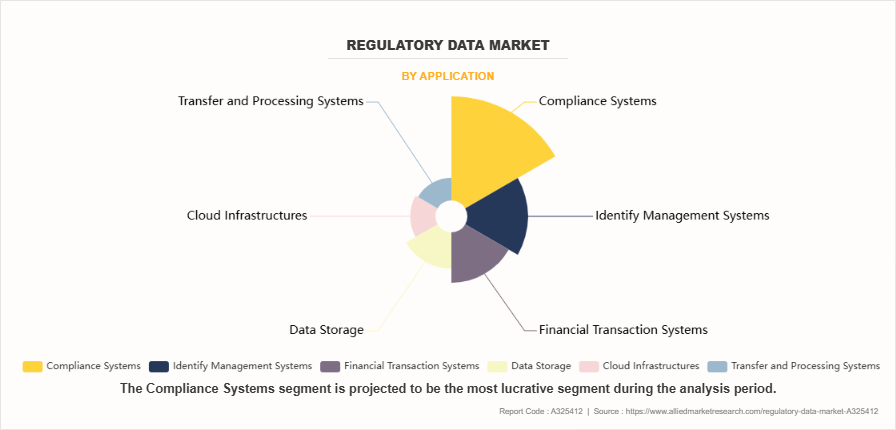
By Source
The organic segment accounted for a major frozen shrimp market size in 2022 and is expected to grow at a significant CAGR during the forecast period. The organic segment holds a major share of the frozen shrimp market owing to the rising demand for eco-friendly and ethically sourced products by consumers. Organic shrimp are grown without the use of synthetic chemicals or antibiotics, which is highly preferred by health-conscious individuals. Additionally, organic farming practices prioritize sustainability and animal welfare, making them even more appealing to environmentally conscious buyers. The demand for organic frozen shrimp is driven by concerns about food safety, environmental sustainability, and ethical sourcing, which has led to its significant market share within the frozen shrimp industry.
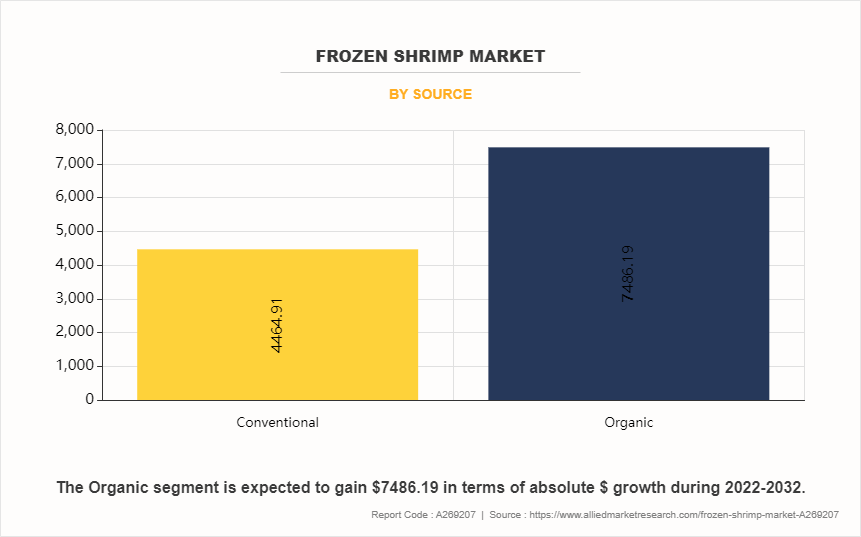
By Distribution Channel
The supermarkets/hypermarkets segment accounted for a major frozen shrimp market share in 2022 and is expected to grow at a significant CAGR during the forecast period. Supermarkets and hypermarkets have a significant share of the frozen shrimp market due to their wide availability, convenience, and diverse range of products. These retail outlets attract a large customer base looking for one-stop shopping for various food items, including frozen seafood. Moreover, supermarkets often offer competitive pricing and promotional deals, making them a preferred choice for budget-conscious consumers. With their extensive refrigeration facilities and efficient supply chains, supermarkets can maintain the quality and freshness of frozen shrimp, further enhancing their appeal and dominance in the distribution of this popular seafood product.
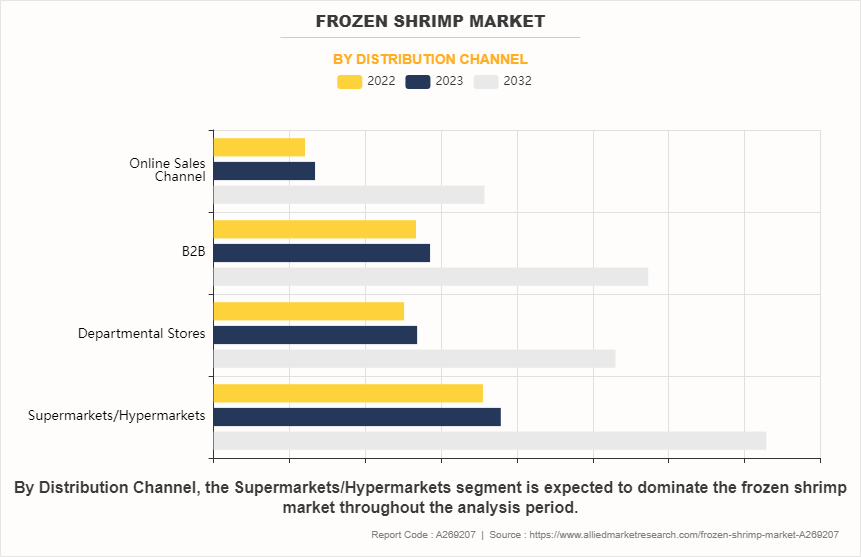
By Region
North America accounted for a major market share in 2022 and is expected to grow at a significant CAGR during the forecast period. The North American region has a considerable and prosperous consumer base with a high demand for seafood products, particularly shrimp. Moreover, North America has advanced infrastructure and distribution networks, which make the supply and distribution of frozen shrimp highly efficient. Cultural preferences and a diverse culinary landscape add to the popularity of shrimp in various cuisines across the continent. Additionally, stringent food safety regulations and quality standards increase consumer confidence in frozen shrimp products, further fueling the growth of the market in North America.
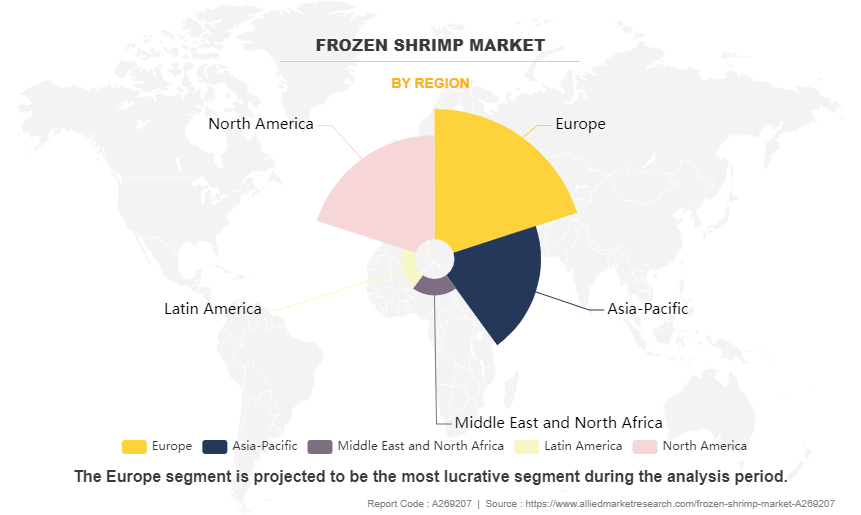
Competitive Analysis
Major players such as SeaPak Shrimp Company, Toyo Suisan Kaisha, High Liner Foods, and Aqua Star Corp. have adopted product approval, partnership, agreement, and acquisition as key developmental strategies to improve the product portfolio of the frozen shrimp market.
Recent Developments in the Frozen Shrimp Industry
In May 2023, Atarraya, an urban farming startup established in 2019, unveiled its e-commerce platform aimed at offering locally sourced and sustainable shrimp to consumers. Utilizing technology to control and oversee the environment, the company transforms cargo containers into Shrimpboxes for shrimp cultivation.
In October 2021, Vertical Oceans, a startup specializing in sustainable shrimp farming in aqua towers, disclosed raising $3.5 million in a seed funding round spearheaded by Khosla Ventures. The company highlighted that its towers can nurture shrimp without resorting to antibiotics or chemicals, thereby promoting a more environmentally friendly approach.
Key Benefits for Stakeholders
- This report provides a quantitative analysis of the market segments, current trends, estimations, and dynamics of the frozen shrimp market analysis from 2022 to 2032 to identify the prevailing frozen shrimp market opportunities.
- Market research is offered along with information related to key drivers, restraints, and opportunities.
- Porter's five forces analysis highlights the potency of buyers and suppliers to enable stakeholders to make profit-oriented business decisions and strengthen their supplier-buyer network.
- In-depth analysis of the frozen shrimp market segmentation assists in determining the prevailing market opportunities.
- Major countries in each region are mapped according to their revenue contribution to the global market.
- Market player positioning facilitates benchmarking and provides a clear understanding of the present position of the market players.
- The report includes an analysis of the regional as well as global frozen shrimp market trends, key players, market segments, application areas, and market growth strategies.
Frozen Shrimp Market Report Highlights
| Aspects | Details |
| Forecast period | 2022 - 2032 |
| Report Pages | 345 |
| By Application |
|
| By Source |
|
| By Distribution Channel |
|
| By Region |
|
| Key Market Players | Clearwater Seafood, Aqua Chile, Thai Union Group, SeaPak Shrimp Company, High Liner Foods, Seafood Co., Aqua Star Corp., Surapon Foods, Toyo Suisan Kaisha, Nordic Seafood A/S |
Analyst Review
According to the insights of the CXOs, the global frozen shrimp market is expected to witness robust growth during the forecast period. This is attributed to the influence of celebrity chefs and culinary trends in the market. The influence of celebrity chefs and culinary trends plays a significant role in surging market demand for frozen shrimp. Celebrity chefs often showcase shrimp in their recipes on cooking shows, social media, and cookbooks, thereby popularizing its use among their followers and the wider audience. Their endorsement and creative culinary presentations inspire consumers to incorporate shrimp into their meals, leading to increased demand for frozen shrimp products.
CXO further added that as culinary trends evolve, frozen shrimp manufacturers respond by offering innovative and convenient shrimp products that align with consumer preferences. Whether it is ready-to-cook shrimp skewers, pre-marinated shrimp, or shrimp-based meal kits, the market adapts to meet the demand driven by culinary trends. However, seasonal fluctuations in shrimp supply pose a restraint on the frozen shrimp market due to the inconsistency in availability throughout the year.
The global frozen shrimp market size was valued at USD 9.9 billion in 2022, and is projected to reach USD 21.9 billion by 2032.
The global frozen shrimp market is projected to grow at a compound annual growth rate of 8.3% from 2023-2032 to reach USD 21.9 billion by 2032.
The key players profiled in the reports includes Nordic Seafood A/S, Toyo Suisan Kaisha, SeaPak Shrimp Company, Seafood Co., High Liner Foods, Aqua Star Corp., Thai Union Group, Clearwater Seafood, Surapon Foods, Aqua Chile.
North America dominated in 2022 and is projected to maintain its leading position throughout the forecast period.
Health Consciousness and Nutritional Benefits, Convenience and Ease of Preparation, Rise in Popularity of International Cuisines, Growth of the Food Service Industry, Sustainability and Ethical Sourcing, Seasonal Availability and Supply Chain Challenges, Market Opportunities for Sustainable Products majorly contribute toward the growth of the market.
Loading Table Of Content...
Loading Research Methodology...



